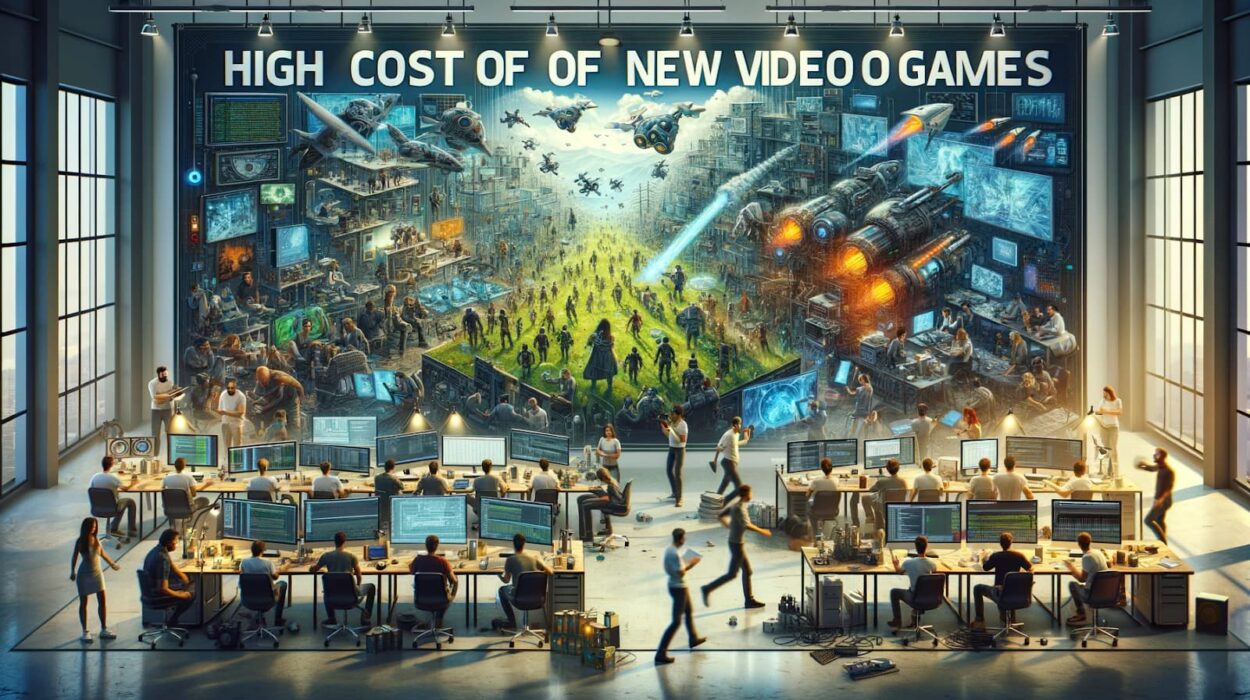The price of brand-new video games has significantly increased in recent years, which has puzzled and alarmed both industry analysts and players. This article explores the many elements that contribute to the high cost of new games as it digs into the complex causes of this trend.
The Evolution of Gaming: A Brief History
The evolution of video games from arcade machines to sophisticated home consoles signifies a significant change in the gaming sector. When arcade games first came out, they provided a straightforward, coin-operated method of playing video games, usually in public areas. But the introduction of home consoles changed this dynamic, allowing video games to be played in the living room. This move involved a change in economic concepts in addition to convenience. The pricing tactics of gaming platforms also changed as they developed. Buying a game outright was made possible by home consoles, as opposed to arcades’ pay-per-play system. The way games were assessed and priced had to change as a result of this transformation, setting the foundation for the cost structures found in contemporary gaming. The complexity and richness of games increased along with the development of consoles, which raised manufacturing costs and, in turn, sale pricing.
The Rise of Triple-A Titles
Triple-A titles have become the pinnacle of quality and value in the ever-evolving world of modern gaming, where possibilities span from the classic gaming platforms to Gamstop-free gaming experiences for as little as £5 deposits. These games are praised for having outstanding production values, which are demonstrated by their sophisticated graphics, gripping narratives, and extensive gameplay. The process of making a Triple-A game involves large teams of developers, artists, and designers working together for several years. The total cost of creating these games is significantly influenced by this large resource commitment. Furthermore, the promotion of these superior games comes at a hefty cost, since publishers spend a lot of money on advertising to make sure that their products stand out in a crowded market. This blend of hefty development and marketing costs ultimately influences the retail pricing of Triple-A games, making them a premium offering even in varied gaming markets, including those offering Gamstop-free gaming with £5 deposit. Consumer expectations have increased due to the growing demand for these premium gaming experiences, which forces game creators to constantly improve the calibre and substance of their products.
Technological Advancements and Production Costs
Technology has changed the game development industry dramatically, adding a new level of complexity and expense with each new breakthrough. Important domains where technology affects the cost of production are:
- Graphics & Visual Effects: Modern, frequently costly graphic design techniques and software are required to achieve photorealistic graphics and complex visual effects in games. The demand for more sophisticated and expensive equipment increases along with the bar for visual fidelity.
- Artificial Intelligence (AI): AI is essential to improving the responsiveness and realism of game characters and environments. It takes a significant investment of time, money, and resources to develop complex AI systems.
- Game engines: Complex engines power everything in modern games, from rendering to physics simulations. Developing a custom game engine or licencing a high-end one requires a substantial financial investment.
- Virtual and Augmented Reality: Adding these immersive experiences to games gets more expensive as VR and AR technology proliferate. Developing for VR/AR calls for specific tools and knowledge.
- Online Infrastructure: Resilient servers and networking infrastructure are necessary for games with online components, which raises the total cost of development.
Talent and Labor: The Human Cost
A diversified team of highly qualified individuals is necessary for the labor-intensive process of developing a video game. A number of factors affect labour expenses in game production, including:
- The core of the game development industry are software developers and programmers, who code the game’s features and dynamics. Competitive salaries are a common result of the computer industry’s high demand for highly competent programmers.
- Artists and animators: These experts are in charge of the game’s visual components, including environment and character design. Labour expenses are impacted by the complex art and animation production, which requires certain talents and a lot of time.
- Sound designers and composers: Creating high-quality audio is essential to the creation of video games. It takes a substantial financial outlay to hire skilled sound designers and composers to produce an interesting auditory environment.
- Story Developers and Writers: With games becoming more narrative-focused, story developers and writers play an increasingly important role and contribute to the expense of human resources.
- Testers for quality assurance (QA): QA testers are essential to making sure the game is free of errors and defects. They need time and labour for their intensive testing procedures.
- Project managers and support personnel: Having more employees is necessary to effectively coordinate and oversee the game development process, which raises labour costs overall.
The Power of Marketing in Gaming
Effective marketing techniques are critical to a video game’s success in the modern market and account for a sizeable portion of the total costs associated with game development and release. Important elements of gaming marketing consist of:
- Campaigns for advertising: These comprise commercials in print media, online banner ads, and YouTube videos. Prominent video games frequently spend a lot of money on advertising in order to reach a large number of people.
- Social Media and Influencer Partnerships: One of the most important aspects of game marketing these days is making use of social media channels and working with streamers and influencers. Budgetary support for sponsorships and promotional initiatives is needed for these initiatives.
- Public Relations and Media Coverage: It’s critical to interact with gaming media for features, interviews, and reviews. This frequently entails holding press conferences or giving game critics early access, which raises the price.
- Promotional Events and Trade fairs: Attending trade fairs and gaming conventions such as PAX, Gamescom, and E3 incurs expenses for promotional products, booth setup, and demos.
- Launch Parties and Live Streams: Setting up launch parties or live broadcasts to create buzz before a game comes out can cost a lot of money.
- Community Management: Marketing costs also include keeping up a lively presence in the gaming community via social media, forums, and customer service.
Consumer Expectations and Market Dynamics
Development costs are rising in the game business due to increased consumer expectations for quality and immersion. Gamers demand complicated gameplay, realistic graphics, and compelling storylines, which calls for the use of cutting-edge technology and highly qualified staff. Time and money resources are used more extensively as a result of these improvements in game production. As a result, developers must balance meeting consumer expectations with recovering their investment, which is reflected in the sale prices of games due to these increased production expenses.
Pricing tactics are influenced substantially by the competitive gaming market. Publishers and developers base their competitive yet profitable pricing decisions on a rigorous analysis of the prices of comparable products in the market. Developers are driven to innovate in order to differentiate their products in a crowded market by adding new features or technologies that can support higher price points. Furthermore, as a result of competitive strategies and market developments, different revenue models such as freemium or subscription services are being used more frequently. In a dynamic market, this competitive landscape influences game pricing in addition to encouraging innovation.







